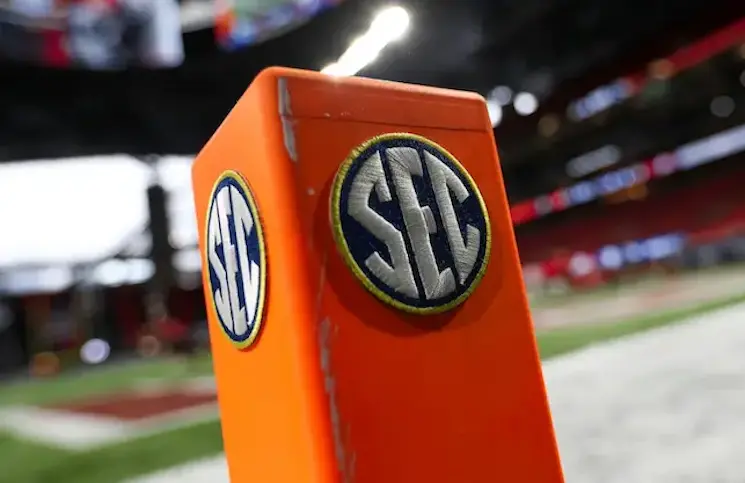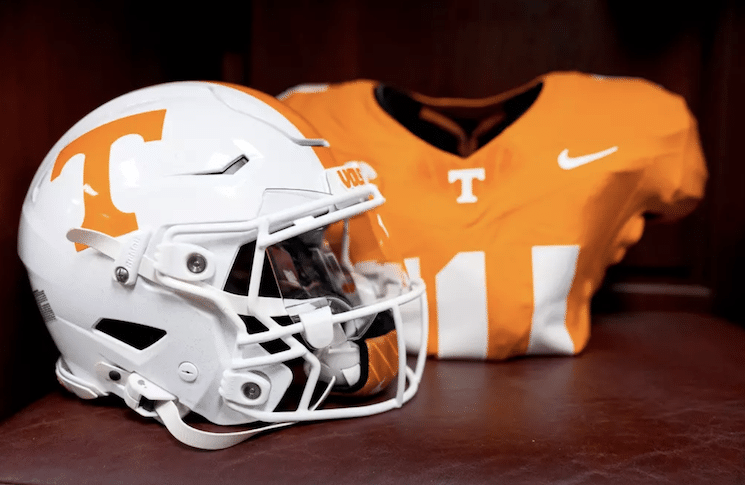Josiah-Jordan James came to Tennessee as a five-star prospect, the first five-star to sign on with the Vols’ men’s basketball program since Robert Hubbs in 2013. Needless to say, expectations were pretty high for the Charleston, South Carolina native.
Unfortunately for the former five-star, his freshman season never quite lived up to expectations.
James played in 27 of Tennessee’s 31 games and had injury issues at the beginning of the year and in the middle of SEC play. He got off to a slow start, and just when it looked like he was starting to find his groove, he had to sit out for two weeks after aggravating a groin/hip injury.
All in all, the 6-foot-6, 207-pound guard finished his first year at Tennessee averaging 7.4 points, 5.5 rebounds, and 2.9 assists in 29.9 minutes a game in 27 contests.
Coming out of high school, James was rated as the No. 22 overall prospect in the 2019 class per the 247Sports Composite rankings. Many Vol fans were hoping to see James average double figures in scoring at the very least, and others thought James could be a one-and-done type of player.
Now, fans are left wondering if James can bounce back after a somewhat subpar freshman campaign.
Were the “one-and-done” expectations too out-of-place for James? And could he be due for marked improvement in his second year in the orange and white?
According to my research, the answer to both of those questions could very well be “yes.”
I took a look at the last five recruiting cycles in men’s basketball (2015-19) and looked at the prospects who were ranked at or around where James was ranked in the 247Sports Composite rankings in each cycle. I looked at players rated two spots better than James’ 22nd spot and two spots lower, meaning the prospects in my research were rated between 20th and 24th in their respective recruiting cycle.
The data came to a pretty stark consensus: Prospects in that range have rarely been true “one-and-done” players over the last five years.
All of the college signees — including James — in that 20-24 ranking range in the 2019 class are coming back to their respective schools for a second year in the upcoming 2020-21 season. Isiah Mobley (20th) is returning to USC, Tre Mann (21st) just announced he’s coming back to Florida, and Keion Brooks Jr. (24th) is the only notable returning member from Kentucky’s 2019-20 roster. LaMelo Ball (23rd) is an outlier, as he elected to go pro overseas rather than head to college.
In fact, out of the four prospects who went to college out of that group, James actually had the highest scoring average (7.4 PPG) and played the most minutes per game (29.9 MPG).
Counting James, only four of the 25 prospects I looked at in that 20-24 range in the 2015-19 classes played one year at their university before going pro. Louis King (20th in 2018) attended Oregon for one season before declaring for the NBA Draft. Jaylen Hoard (24th in 2018) did the same for Wake Forest, playing one season then going pro. Trae Young (23rd in 2017) was a superstar in one season at Oklahoma and went to the NBA, and Omari Spellman (20th in 2016) technically counts as he only played on the court for one year with Villanova, though he redshirted his first year on the roster.
Other than those four, LaMello Ball, and Billy Preston — who was ranked 20th in the 2017 class and signed with Kansas before getting hurt in a car accident, leaving in the middle of the 2017-18 season despite not playing any, and going pro — the rest of players I looked at stayed in college for two or more years.

The vast majority of the 25 players in that ranking range over the last five recruiting cycles played at least two seasons of college ball, with 16 of them (including James) sticking around for at least a second season at their school. Three more prospects ended up using all four years of their college eligibility: Mustapha Heron (22nd in 2016) played two years at Auburn and two years at St. John’s, Jalen Adams (23rd in 2015) played four years at UConn, and Carlton Bragg (24th in 2015) played two years at Kansas then 1.5 years at New Mexico before being dismissed.
Interestingly, every player with the same ranking as James over the last five years (22nd) went on to play at least two years of college basketball. Jalen Brunson (Villanova), Mustapha Heron (Auburn, St. John’s), Jaylen Hands (UCLA), and Immanuel Quickley (Kentucky) all played at least two seasons at their respective schools, just like James is set up to do. In fact, Devin Booker (2014) is the only prospect ranked 22nd in the 247Sports Composite rankings since the 2010 class to go one-and-done in college.
All of that is well and good, but did the players who stuck around for two or more years at their school end up getting better? For the most part, yes.
Nine of the 15 players who played two or more years of college basketball (not counting the 2019 recruits since they haven’t played their second season yet) showed significant improvement from their first to second seasons (at least 3.0 more points per game or strong increases in other stats). Players like Thomas Bryant at Indiana, Mustapha Heron at Auburn, and Rawle Alkins at Arizona saw increases in their points per game and in other areas in their second season, just not as significant as others.
Still not sold? Then let’s look at an example of a Tennessee player who entered UT with similar expectations as James, failed to live up to his billing as a freshmen, but still turned in a very impressive Tennessee career.
Vincent Yarbrough joined the Vols as a top-20 prospect and a highly-coveted recruit out of Cleveland, TN in the 1998 class. Expectations were very high for the in-state standout, but his first season as a Vol — much like James’ — was far from what he and others hoped.
As a freshman, Yarbrough played in 30 games and averaged 7.6 points, 5.2 rebounds, 1.4 assists, and 1.4 steals while shooting 41.7 percent overall and 27.4 percent from three in 23.5 minutes a game.
Do those stats sound familiar?
James’ freshman season saw him average 7.4 points, 5.5 rebounds, 2.9 assists, and 0.9 steals while shooting 37.0 percent overall and 36.7 percent from three in 29.9 minutes a game in 27 contests.
Yarbrough, a 6-foot-7, 210-pound small forward, would go on to average 14.8 points, 6.9 rebounds, 2.5 assists, and 1.7 steals as a sophomore while shooting 46.7 percent overall and 35.8 percent from three in 33 games in the 1999-2000 season. In fact, by the time Yarbrough graduated and left UT after the 2001-02 season, he finished his career as a top-10 all-time scorer for the Vols, and his 1,737 career points still place ninth all-time in school history.
Could a similar trajectory be in store for James? I actually talked extensively about that in an episode of the RTI Podcast with Gene Henley of the Times Free Press back in February of this year, but there’s plenty of reason to believe that could be the case.
James, who has a similar build to Yarbrough at 6-foot-6, 207 pounds, had similar struggles to Yarbrough as a freshman, and injuries really held James back on offense. Defensively, James was one of the better players on the team, but his work on defense didn’t always show up on the stat sheet.
What fans pay attention to more is what players do on the offensive end. And if Rick Barnes’ words this offseason are to be believed, fans may see a new, reinvigorated version of James in the 2020-21 season.
Barnes said earlier this offseason that James has “transformed his body” and improved his flexibility by practicing yoga in the offseason. Last year, James missed essentially all of UT’s preseason preparation with an injury, and then injuries hampered him midway though the actual season.
If healthy, James has a chance to really shine. Both the history of recruiting rankings and UT’s own history have precedent for this.

James played a significant role for Tennessee last season, and he had to. The freshman averaged the fifth-most minutes among UT’s players who played at least half the season, and when he was absent from the starting lineup in SEC play, Tennessee struggled to replace him with Jalen Johnson and Uros Plavsic taking starting duties temporarily.
With Jordan Bowden and Jalen Johnson departing from the roster this offseason, James looks to be in line for a bigger role. But he’ll also have something this year he didn’t have much of last year: competition.
James almost started by default last season. Yes, he was talented, but other than Jalen Johnson, Tennessee didn’t have anyone else to start alongside Jordan Bowden and Lamonte Turner in the backcourt. Then once Turner went down and Santiago Vescovi entered mid-year, James took on an even bigger role and consistently played large chunks of minutes. James played 30 or more minutes in 17 of the 27 games he appeared in for Tennessee last season.
As a freshman, James didn’t have to worry too much about his starting job being taken from him. But heading into his sophomore year, he has some very talented youngsters ready to steal those minutes away from him.
Five-star guards Jaden Springer and Keon Johnson will have roles of some sort on Tennessee’s team this upcoming season, and James will have to fend both off for playing time in what looks to be a loaded and deep UT roster. Not only that, but Santiago Vescovi will finally have a full offseason to learn and grow, likely further cementing himself as the team’s point guard. That doesn’t leave James a ton of options as a point-forward type of player he was at times last year.
Competition brings out the best in true ballers, and James will have to prove that this upcoming season. Because there won’t be much lack of competition at any position for the Vols this season, especially in the backcourt.
Were expectations too high for Josiah-Jordan James coming into Tennessee? Possibly. Is he capable of taking a pretty significant step forward as a sophomore and getting closer to living up to those expectations? History says that’s very likely.
Only time will tell, but it’s far, far too early for fans to give up on James right now. The potential is there, and his defense alone will keep him on the court. He just needs to find more of an offensive identity, and the pieces are more than capable of sliding into place for the former five-star.



